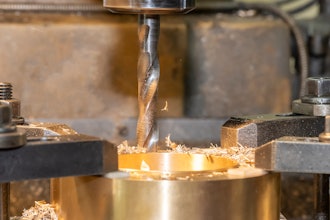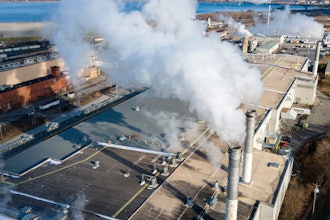TEMPE, AZ — Economic growth is expected to continue in the U.S. throughout the remainder of 2017, say the nation's purchasing and supply executives in their Spring 2017 Semiannual Economic Forecast. Expectations for the remainder of 2017 continue to be positive in both the manufacturing and non-manufacturing sectors.
These projections are part of the forecast issued by the Business Survey Committee of the Institute for Supply Management (ISM). The forecast was presented today by Bradley J. Holcomb, CPSM, CPSD, chair of the ISM Manufacturing Business Survey Committee; and by Anthony S. Nieves, CPSM, C.P.M., A.P.P., CFPM, chair of the ISM Non-Manufacturing Business Survey Committee.
Manufacturing Summary
Sixty-four percent of respondents from the panel of manufacturing supply management executives predict their revenues will be 8.5 percent greater in 2017 compared to 2016, 12 percent expect a 9.6 percent decline, and 24 percent foresee no change in revenue. This yields an overall average forecast of 4.4 percent revenue growth among manufacturers for 2017. This current prediction is 0.2 percentage point below the December 2016 forecast of 4.6 percent revenue growth for 2017, but is 3.5 percentage points above the actual revenue growth reported for all of 2016. With operating capacity at 82.5 percent, an expected capital expenditure increase of 5.2 percent, an increase of 2.5 percent for prices paid for raw materials, and employment expected to increase by 1.3 percent by the end of 2017 compared to the end of 2016, manufacturing is positioned to grow revenues while managing costs through the remainder of the year. "With 17 of the 18 industries within the manufacturing sector predicting revenue growth in 2017, when compared to 2016, U.S. manufacturing continues to move in a positive direction," said Holcomb.
The 17 industries reporting expectations of growth in revenue for 2017 — listed in order — are: Electrical Equipment, Appliances & Components; Textile Mills; Computer & Electronic Products; Furniture & Related Products; Apparel, Leather & Allied Products; Primary Metals; Paper Products; Fabricated Metal Products; Miscellaneous Manufacturing; Food, Beverage & Tobacco Products; Petroleum & Coal Products; Plastics & Rubber Products; Machinery; Chemical Products; Wood Products; Nonmetallic Mineral Products; and Printing & Related Support Activities.
OPERATING RATE
Manufacturing: Purchasing and supply managers report that their companies are currently operating on average at 82.5 percent of normal capacity, representing a small increase from the 81.9 percent reported in December 2016, as well as slightly larger increase from the 81.7 percent reported in April 2016. The 11 industries reporting operating capacity levels at or above the average capacity of 82.5 percent — listed in order — are: Wood Products; Paper Products; Petroleum & Coal Products; Plastics & Rubber Products; Apparel, Leather & Allied Products; Miscellaneous Manufacturing; Nonmetallic Mineral Products; Computer & Electronic Products; Chemical Products; Food, Beverage & Tobacco Products; and Electrical Equipment, Appliances & Components.
PRODUCTION CAPACITY
Manufacturing: Production capacity in manufacturing is expected to increase 3.3 percent in 2017. This increase is less than the 4.2 percent increase predicted in December 2016 for 2017, but is greater than the 2.5 percent increase reported in December 2016 for all of 2016. This reflects the continuing strength in the sector as 38 percent of respondents expect an average capacity increase of 10.9 percent, 7 percent expect decreases averaging 13.7 percent, and 55 percent expect no change. The 15 industries expecting production capacity increases for 2017 — listed in order — are: Textile Mills; Electrical Equipment, Appliances & Components; Fabricated Metal Products; Computer & Electronic Products; Miscellaneous Manufacturing; Nonmetallic Mineral Products; Petroleum & Coal Products; Furniture & Related Products; Plastics & Rubber Products; Chemical Products; Apparel, Leather & Allied Products; Food, Beverage & Tobacco Products; Machinery; Primary Metals; and Paper Products.
PREDICTED CAPITAL EXPENDITURES — 2017 vs. 2016
Manufacturing: Survey respondents expect a 5.2 percent increase in capital expenditures in 2017. This is notably higher than the 0.2 percent increase predicted by the panel in the December 2016 forecast for 2017. Currently, 30 percent of respondents predict increased capital expenditures in 2017, with an average increase of 32.9 percent, and the 17 percent who said their capital spending would decrease an average of 27 percent. Fifty-three percent say they will spend the same in 2017 as they did in 2016.The 11 industries expecting increases in capital expenditures in 2017 compared to 2016 — listed in order — are: Paper Products; Plastics & Rubber Products; Textile Mills; Furniture & Related Products; Electrical Equipment, Appliances & Components; Chemical Products; Fabricated Metal Products; Computer & Electronic Products; Petroleum & Coal Products; Nonmetallic Mineral Products; and Apparel, Leather & Allied Products.
PRICES — Changes Between End of 2016 and April 2017
Manufacturing: In the December 2016 forecast, respondents predicted an increase of 0.9 percent in prices paid during the first four months of 2017; and they now report prices have increased by 2.2 percent for the same period. The 55 percent who say their prices are higher now than at the end of 2016 report an average increase of 4.9 percent, while the 11 percent who report lower prices report an average decrease of 4.2 percent. The remaining 34 percent indicate no change for the period. Of the 18 manufacturing industries, the 16 industries that reported an increase in prices paid for the first part of 2017 — listed in order — are: Fabricated Metal Products; Plastics & Rubber Products; Primary Metals; Textile Mills; Chemical Products; Machinery; Electrical Equipment, Appliances & Components; Paper Products; Furniture & Related Products; Nonmetallic Mineral Products; Apparel, Leather & Allied Products; Computer & Electronic Products; Petroleum & Coal Products; Transportation Equipment; Food, Beverage & Tobacco Products; and Miscellaneous Manufacturing.
PRICES — Predicted Changes Between End of 2016 and End of 2017
Manufacturing: When asked to predict 2017 price changes, 64 percent of respondents expect the prices they pay to increase by 4.8 percent for the full year of 2017 compared to the end of 2016. At the same time, 13 percent anticipate decreases averaging 4.5 percent. Including the 23 percent who expect no change in prices, survey respondents expect net average prices to increase by 2.5 percent for the entire year 2017, indicating that prices are expected to rise 0.3 percentage point over the remainder of the year. Out of 18 manufacturing industries, 17 are predicting increases in prices for all of 2017 in the following order: Fabricated Metal Products; Textile Mills; Machinery; Petroleum & Coal Products; Furniture & Related Products; Chemical Products; Nonmetallic Mineral Products; Electrical Equipment, Appliances & Components; Paper Products; Food, Beverage & Tobacco Products; Miscellaneous Manufacturing; Primary Metals; Printing & Related Support Activities; Computer & Electronic Products; Plastics & Rubber Products; Apparel, Leather & Allied Products; and Transportation Equipment.
EMPLOYMENT — Predicted Changes Between End of 2016 and End of 2017
Manufacturing: ISM's Manufacturing Business Survey respondents forecast that manufacturing employment will increase by 1.3 percent by the end 2017 compared to the end of 2016. Thirty-five percent of respondents expect employment to be 6.3 percent higher, while 12 percent of respondents predict employment to be lower by 7.3 percent. The remaining 53 percent of respondents expect their employment levels to be unchanged for the remainder of 2017. The 13 industries reporting expectations of growth in employment during 2017 — listed in order — are: Computer & Electronic Products; Electrical Equipment, Appliances & Components; Furniture & Related Products; Plastics & Rubber Products; Machinery; Nonmetallic Mineral Products; Miscellaneous Manufacturing; Textile Mills; Fabricated Metal Products; Paper Products; Food, Beverage & Tobacco Products; Printing & Related Support Activities; and Chemical Products.
BUSINESS REVENUES Comparison — 2017 vs. 2016
Manufacturing: Looking ahead, expectations are for increased revenues in 2017 as purchasing and supply management executives predict an overall net increase of 4.4 percent in business revenues for 2017 over 2016. This is 0.2 percentage point lower than the 4.6 percent increase forecast in December 2016 for all of 2017, and 3.5 percentage points higher than the 0.9 percent increase reported for 2016 over 2015. Sixty-four percent of respondents say that revenues for 2017 will increase an average of 8.5 percent over 2016. Conversely, 12 percent say their revenues will decrease an average of 9.6 percent, and the remaining 24 percent indicate no change. Of the 18 manufacturing industries, 17 are reporting expectations of growth in revenue during 2017 — listed in order — are: Electrical Equipment, Appliances & Components; Textile Mills; Computer & Electronic Products; Furniture & Related Products; Apparel, Leather & Allied Products; Primary Metals; Paper Products; Fabricated Metal Products; Miscellaneous Manufacturing; Food, Beverage & Tobacco Products; Petroleum & Coal Products; Plastics & Rubber Products; Machinery; Chemical Products; Wood Products; Nonmetallic Mineral Products; and Printing & Related Support Activities.























